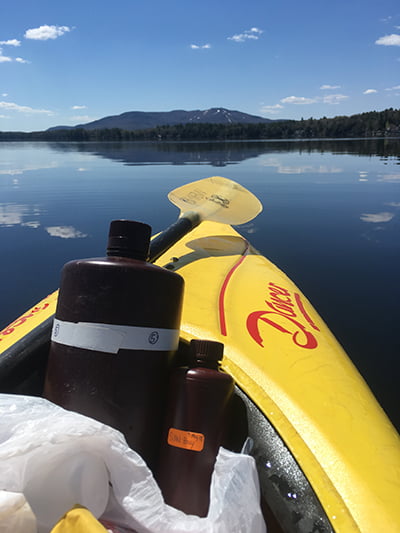As many of us prepare to travel to lakes and other bodies of water this summer for relaxation and recreation, now is the perfect time to consider what we can do to help protect the lakes we love.

Scientists have long studied the ecological impact of humans on lakes, but a new study led by researchers at Virginia Tech explores how those ecological impacts can cycle back to affect humans. The study, published in the journal Ecosphere, offers a new model for those invested in protecting and maintaining lakes.
“Lakes provide so much in terms of drinking water, recreation, aesthetic value, and more,” said Kelly Cobourn, assistant professor of water resource policy in Virginia Tech’s College of Natural Resources and Environment, and project lead. “People derive a lot of value from connecting with lakes. We also understand that humans degrade the quality of lakes with some of the choices they make. We provide a roadmap for understanding and approaching these problems that hasn’t been used before.”
The study, which is in its third year, brings together researchers from Virginia Tech, The Pennsylvania State University, University of Wisconsin, Cornell University, Michigan State University, and Cary Institute of Ecosystem Studies.
The team uses coupled natural and human systems modeling to understand how humans and the environment affect one another.
“Similar research in the past has looked at the effects humans have on lakes, but rarely has anyone completed the loop of looking at how lakes affect humans,” said Cayelan Carey, assistant professor in the Department of Biological Sciences in Virginia Tech’s College of Science. “This paper focuses on completing the feedback loop that captures human actions, the consequences of those actions for water quality in lake ecosystems, and the effect of ecosystem change on human behavior.”
The researchers examined three lake catchments, or areas of land where water runs into a freshwater lake — Lake Mendota in Wisconsin, Oneida Lake in New York, and Lake Sunapee in New Hampshire. The team collected data on land-use and management decisions, how water and sediment are transported to the lake, and how those things affect water quality by changing levels of chemicals that may affect the color or clarity of the lake.
“Agriculture is a huge source of nitrogen and phosphorous loaded into lakes and watersheds,” explained Cobourn, a faculty member in the Department of Forest Resources and Environmental Conservation. “We are looking at how farmers decide which crops to plant, how much land is used, and how fertilizer is applied. While fertilizers can help improve crop yields, they also leach into lakes.”
Carey, who is working on understanding how human decisions like land development or the application of fertilizer affected the ecosystem, added, “With this data, we can run ‘what if?’ scenarios to see how things might change under different conditions. For instance, what would happen to algal blooms if farmers don’t use any fertilizer at all? What would happen if they use 50 percent more fertilizer?”
From there, the researchers moved on to focus on how changes in water quality affect shorefront property values and whether those changes motivate civic action by lake associations and other concerned groups. Kevin Boyle, professor in the Department of Agricultural and Applied Economics in Virginia Tech’s College of Agriculture and Life Sciences, studied the factors that affect the value of properties surrounding lakes.
“Lakes provide important and unique ecosystems,” Boyle said. “A lake that is clear and healthy is going to hold more value to people than one that isn’t. The property-value impacts can be used as an educational tool, because we now have information about the economic benefits of protecting lakes, in addition to the ecological ones.”
A critical relationship between lakes and people arises when citizens participate in civic action to protect ecosystems. According to Michael Sorice, associate professor in the Department of Forest Resources and Environmental Conservation, volunteer organizations like lake associations are common in areas surrounding lake catchments because of the nonmonetary value people associate with lakes.
“Lakes are magnetic to people,” he said. “They are important for outdoor recreation, aesthetic value, historical significance, and more. We are trying to understand how lake associations encapsulate all of those values and use them to influence lake water quality.”
Added Carey, “We were actually hosted by the Lake Sunapee Protective Association in New Hampshire recently. They were excited to use the models we came up with to help improve their lake.”
Kelly Cobourn, Cayelan Carey, and Michael Sorice are also affiliated with the Global Change Center housed in Virginia Tech’s Fralin Life Science Institute.
This project aligns with Virginia Tech’s Global Systems Science Destination Area, which fosters transdisciplinary study of the dynamic interplay between natural and social systems. Research in this area involves faculty collaboration as a means to discover creative solutions to critical social problems emergent from human activity and environmental change in areas such as freshwater systems.


